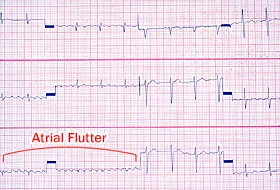Atrial fibrillation is the most common abnormal heart rhythm among U.S. But with the right treatment plan for Afib, you can live a long and healthy life. Working with your doctor to. Your heartbeat is a sort of electrical circuit. Sometimes the signals cause it go awry. Atrial flutter results from an abnormal circuit inside the right atrium, or upper chamber. I was taking Amiodarone, together with Digoxin and low dose aspirin, for about 3 years to control occasional episodes of atrial fibrillation. The episodes were incapacitating. Amiodarone side effects became so severe that my doctor just now prescribed Veramil ER instead.
Atrial flutter is a type of abnormal heart rhythm, or arrhythmia. It occurs when a short circuit in the heart causes the upper chambers (atria) to pump very rapidly. Atrial flutter is important not only because of its symptoms but because it can cause a stroke that may result in permanent disability or death.
What happens during atrial flutter?
A normal heartbeat begins with an electrical impulse from the sinus node, a small area in the heart's right atrium (right upper chamber). During atrial flutter, the short circuit — a circular electrical pathway — allows the electrical impulse to quickly move around the right atrium, causing between 240 and 340 contractions per minute. Rapid contractions prevent the chambers from filling completely between beats.
The ventricles (lower chambers) also beat faster, though not usually quite as fast. The rate is based on the ratio of atrial beats to ventricular beats. For example, a 2:1 block means that for every two beats in the atria, the ventricles beat once.
An arrhythmia centered in the upper chambers of the heart is called a supraventricular tachycardia (SVT), literally 'fast heartbeat above the ventricles.' Note that when you feel your pulse — for example, at your wrist or neck — you are feeling the beat of the left ventricle as it pumps blood to your arteries. A normal heart rate is between 60 and 100 beats per minute.
What are the different types of atrial flutter?
Atrial flutter is classified as typical or atypical (non-typical) depending on the location of the short circuit — the pathway that allows the electrical signal to move too fast around the heart. While the symptoms are similar, the treatments may differ.
Typical atrial flutter is localized to the right atrium. This type of atrial flutter can be cured with a short outpatient catheter ablation procedure.
Atypical atrial flutter refers to atrial flutter arising in the left atrium. Most types of atypical atrial flutter can also be treated with catheter ablation, but the procedure is longer and more involved.
What are the symptoms of atrial flutter?

Atrial flutter may cause no symptoms at all, or they may cause any of the following:
Stroke
Palpitations (a fluttering in the chest)
Dizziness or fainting
Shortness of breath
Fatigue
What causes atrial flutter?
Atrial flutter is usually an age-related arrhythmia because it rarely occurs before the age of 50 but then becomes more common. Other causes include:
Prior cardiac surgery
Prior catheter ablation for atrial fibrillation
What are the complications of atrial flutter?

Atrial flutter may cause no symptoms at all, or they may cause any of the following:
Stroke
Palpitations (a fluttering in the chest)
Dizziness or fainting
Shortness of breath
Fatigue
What causes atrial flutter?
Atrial flutter is usually an age-related arrhythmia because it rarely occurs before the age of 50 but then becomes more common. Other causes include:
Prior cardiac surgery
Prior catheter ablation for atrial fibrillation
What are the complications of atrial flutter?
Blood left to pool in the upper chambers after an inefficient heartbeat increases the risk of clot formation. If a blood clot travels from the heart into the bloodstream, it could become lodged in an artery and cause a stroke.
Free slots 888 no download. If the heart beats very quickly over a long period of time, it may lead to cardiomyopathy, a weakening of the heart muscle.
How is atrial flutter diagnosed?
Atrial flutter is normally diagnosed in your physician's office using an electrocardiogram (ECG or EKG). If the diagnosis is still in question, your doctor may recommend a Holter monitor, an event monitor or an electrophysiological study, during which a narrow, flexible tube called a catheter is threaded through a vein to your heart under light sedation. Fine wires inside the catheter can help pinpoint the abnormal signal.
How is atrial flutter treated?
Sometimes, atrial flutter goes away by itself and no further action is needed. If it persists, your doctor may pursue any of the following treatments:
Treatment of any underlying conditions
Catheter ablation — procedure to destroy the errant electrical pathways; performed together with an electrophysiological study
Cardioversion — small, controlled shock to the chest done under anesthesia to provide short-term correction of the heart rhythm
Medications to control the heart rhythm, called antiarrhythmics, may be less effective than catheter ablation
Medications to prevent blood clots
Occasional Afib Fluttering
For more information about arrhythmias and their tests and treatments, visit the arrhythmias page or the Johns Hopkins Electrophysiology and Arrhythmia Service.

